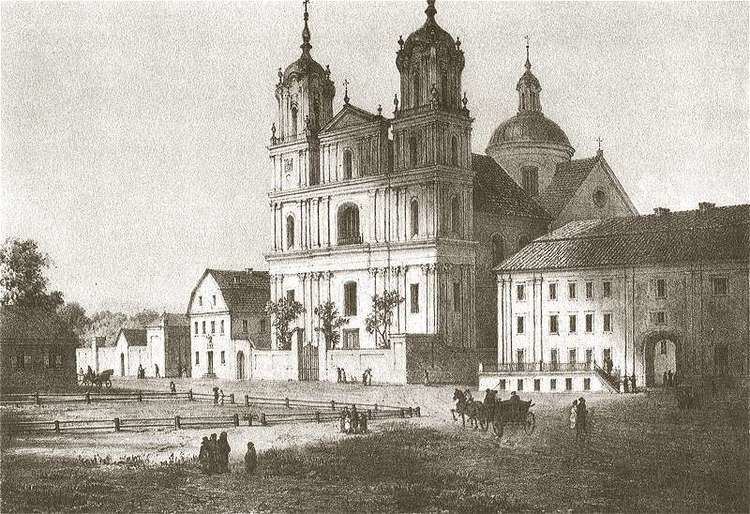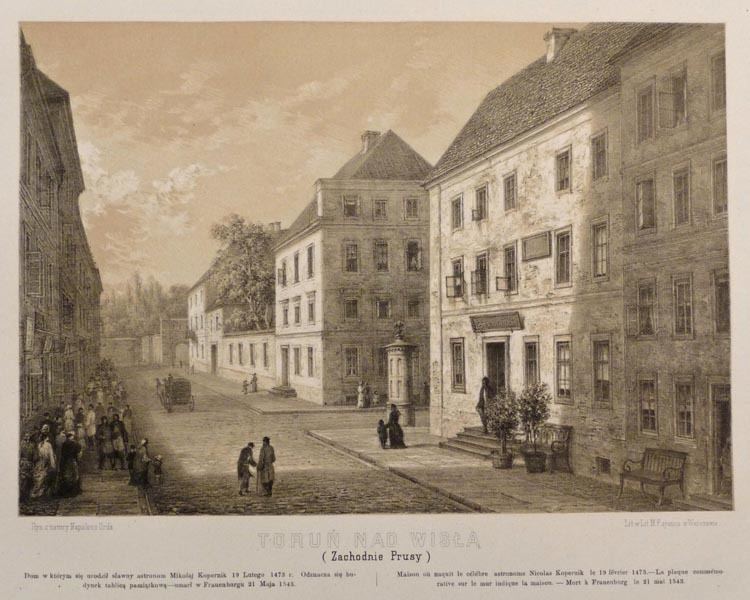Name Napoleon Orda Role Musician | Education Vilnius University | |
 | ||
Died April 26, 1883, Warsaw, Poland | ||
2016 Junior B 3. Prize Palina Novikava
Napoleon Mateusz Tadeusz Orda (Belarusian: Напалео́н О́рда; February 11, 1807 – April 26, 1883) was a Polish-Lithuanian musician, pianist, composer and artist, best known for numerous sketches of historical sites of present-day Belarus, Lithuania, and Poland.
Contents

Biography

Napoleon Orda was born in the village of Worocewicze in the Pinsk district of Minsk Governorate (now Ivanava Raion, Brest Region, Belarus) in his father's manor. His father Michał Orda was an impoverished noble of Lithuanian ancestry and the marshal of the powiat of Kobryn. After finishing Svislach gymnasium in 1823, he started mathematical studies at the Vilnius University. However, his university career came to an end on August 27, 1826 when he was arrested by the Russian secret police for taking part in a secret student society "Zorzanie", which was active in Svislach and Białystok gymnasiums. Although he was released soon afterwards, he was expelled from the university and was not allowed to continue his studies.

Napoleon Orda took part in the failed November Uprising of 1830 against Russia and served with distinction in the famous 4th Regiment (Czwartacy). For his bravery he received the highest Polish military decoration, the Virtuti Militari. After the uprising his manor was confiscated and Orda had to flee abroad in order to avoid being imprisoned and sent to Siberia.

He travelled through many European countries, including Italy and Switzerland. Finally in 1833, he settled in Paris, where he became one of the prominent members of the Polish diaspora there and one of the close friends of Fryderyk Chopin. He studied piano play under the guidance of Chopin and Franz Liszt and wrote several mazurkas, waltzes and polonaises. While in Paris he also studied painting briefly with Pierre Girard and started to portray his long lost motherland in countless sketches.
In Paris, Orda married Irene Bougle and worked as the head of Maison de Commission shop. He was also the head of the Italian Opera in Paris, until it was closed due to the February Revolution of 1848. He was also an active member of various Polish political and social organisations, including and the Committee of Polish Emigrants. Most of his spare time he spent travelling. He visited France, England, Scotland, Belgium, the Netherlands, Lorraine, Spain, Portugal and Algeria.
During the Post-Sevastopolian Thaw in 1856 he was pardoned by tsar Alexander II and was allowed to return home. He was also restored the rights to his village of Varacevičy. In 1859 he requested from tzar and had received back his money that were confiscated together with his estate. In 1862 he moved to Wierzchownia in today's Ukraine, where he served as a manager of general Adam Rzewuski's domain.
In 1872 Orda started to travel throughout the partitioned Republic of Both Nations and document its historical landmarks and architecture. During his summer trips throughout the country he made more than 1000 sketches depicting various towns, cities and historical landscapes. He also depicted landscapes, urban and rural architecture, churches and palaces of partitioned Commonwealth - regions of today's Belarus, Lithuania, Poland, Ukraine, as well as several regions of France, Germany, Portugal and Switzerland. His works are pencil sketches tinted with watercolour, gouache and sepia. Between 1872 and 1874 he visited most of the notable castles, manors and towns in Volhynia, Podolia and Ukraine. Until 1877 he documented the historical heritage of Lithuania, Samogitia, Livonia and Belarus. In 1878 and 1879 he made a trip to Galicia, Greater Poland and Royal Prussia and finally in 1880 he portrayed the Kingdom of Poland. Approximately 260 of his sketches were turned into lithographies by Alojzy Misierowicz and published in Warsaw by Maksymilian Fajans in a series of 8 albums under the collective title Album of Polish Historical Landscapes (Polish: Album widoków historycznych Polski) between 1873 and 1883.
In his testament he bequeathed his sketches to the Polish people and currently most of his works are kept in the National Museum in Kraków and Warsaw. Besides their artistic value, they are a priceless source of information on the history and architecture of Poland, Belarus and Ukraine, whose historical heritage was largely destroyed by the Germans during World War II.
Napoleon Orda died April 26, 1883, in Warsaw but according to his last will he was buried in his native land, in Ivanava village, near Kobryn (currently Brest voblast of Belarus) in his family crypt. In 1980s the cemetery was destroyed by Soviet authorities in order to build a kindergarten in its place. After some time the gravestone from Orda's tomb was found and removed to a museum in Pinsk.
Orda's niece was the artist Helena Skirmunt.
Commemoration of Orda in Belarus
In 1997, a monument to Napoleon Orda was erected in the town of his burial by sculptor Ivan Holubieu.
In 2007 National Bank of Belarus issued silver and copper-nickel memory coins, devoted to the 200th anniversary of Napoleon Orda. His work of Nesvizh Castle was also placed on the banknote of 100 000 BYR.
The streets were named after Orda in Minsk and Grodno.
In 2010 Google commemorated Orda’s date of birth by placing special logo with his work in Belarusian version of the search service.
